Classes of hazardous materials

What are the classes of hazardous materials?
Hazardous material classes are a way of classifying dangerous goods according to the UN (United Nations). There are 9 classes of hazardous materials and each class is described by two types of digital codes:
- UN number;
- classification code (except for class 7).
In addition, for some classes of hazardous goods there are so-called packaging groups. They indicate the degree of risk posed by the goods. There are three packaging groups:
- Packing group I - high-risk materials;
- Packing group II - medium-hazardous materials;
- Packing group III - low-risk materials.
Why is the classification of hazardous materials important?
The classification of hazardous materials is important to manage transport safety, the safety of people, and the environment. The most important reasons why is the classification of hazardous materials important are:
- Transport safety - The classification of hazardous materials allows for the proper ADR labelling and packaging of dangerous goods, which increases safety during transport. This allows drivers, warehouse staff, and others involved in transport to properly secure cargo and avoid dangerous situations.
- Safety of people and the environment - The classification of hazardous materials allows for the proper processing and storage of dangerous goods, which minimises the risk of accidents and breakdowns. Risks to human health and the environment can thus be avoided.
- Regulatory compliance - The classification of hazardous materials is required by law, including ADR. Therefore, it is important for businesses that transport and process hazardous materials to be aware of and comply with the regulations.
- Effective assistance in case of an accident - The classification of hazardous materials allows quick and effective action in case of an accident. It enables the emergency services to respond appropriately and minimise the consequences of an accident.
What are the standards for classifying hazardous materials?
The main standards for classifying hazardous materials are:
- ADR (European Agreement on the International Carriage of Dangerous Goods by Road Dangerous Goods). Under ADR, hazardous materials are divided into nine classes and several hazard subclasses (13 in total).
- RID (European Agreement concerning the International Carriage of Dangerous Goods by Rail). Under RID, hazardous materials are subdivided in the same way as in ADR.
- IMDG (International Maritime Dangerous Goods Code). Under the IMDG, hazardous materials are divided into nine hazard classes. ● IATA (International Air Transport Association). Under IATA, hazardous materials are divided into 9 hazard classes.
- DOT (United States Department of Transportation). Distinguishes 9 hazard classes.
- NFPA 400 (National Fire Protection Association in the United States). It distinguishes 14 hazard classes.
As all of the above standards (not counting NFPA 400) are almost identical, as they are based on the United Nations classification, we will focus on the latter two in the following text.
What is a DOT standard?
A DOT standard is a set of regulations governing the transport of hazardous materials by air, rail, land or sea. The standard is intended to ensure the safe transport of hazardous materials for industry and consumers.
The definition of hazardous materials includes materials identified by the Secretary of the US Department of Transportation as posing an unreasonable risk to health, safety and property during transportation in commerce.
The DOT standard is enforced by the Pipeline and Hazardous Materials Safety Administration (PHMSA). It includes requirements for labelling, packaging and handling of hazardous materials, as well as training and certification of personnel involved in the transport of hazardous materials.
The standard also covers emergency response requirements for accidents or incidents involving hazardous materials.
The classes of hazardous materials according to DOT are as follows:
- Class 1: Explosives;
- Class 2: Gases;
- Class 3: Flammable liquids;
- Class 4: Flammable solids, spontaneously combustible and hazardous in contact with water;
- Class 5: Oxidising substances and organic peroxides;
- Class 6: Toxic and infectious materials;
- Class 7: Radioactive materials;
- Class 8: Corrosive materials;
- Class 9: Miscellaneous.
What is NFPA 400?
NFPA 400 is a standard for hazardous materials that consolidates the basic rules for the storage, use and handling of hazardous materials in all facilities and premises. However, it does not apply to the storage or use of hazardous materials for individual use in single-family and two-family dwellings.
NFPA 400 has its own definition and classification method, which consists of 14 different categories, which distinguishes it from the classification system used by DOT.
The classes of hazardous materials according to NFPA 400 are as follows:
- Corrosive solids, liquids or gases;
- Flammable solids;
- Flammable gases;
- Flammable cryogenic liquids;
- Inert cryogenic fluids;
- Inert gases;
- Organic peroxide preparations;
- Solid or liquid oxidizers;
- Oxidizing gases;
- Oxidising cryogenic liquids;
- Pyrophoric solids, liquids or gases;
- Toxic or highly toxic solids, liquids or gases;
- Unstable (reactive) solids, liquids or gases;
- Water-reactive solids or liquids.
This standard also includes requirements for oxidisers, organic peroxides, pesticides and ammonium nitrates, based on requirements from previous documents: NFPA 430, NFPA 432, NFPA 434 and NFPA 490.
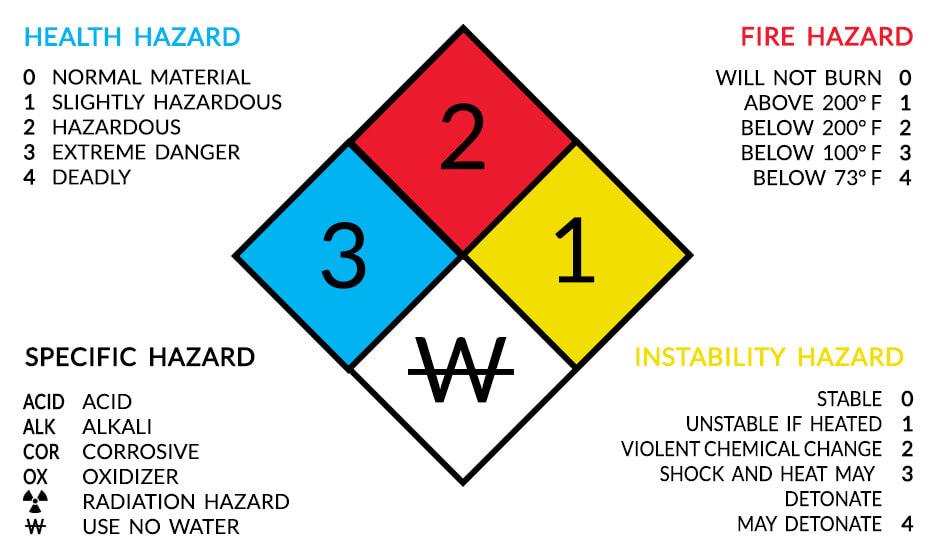
Classes of hazardous materials according to the ADR standard
In this part of the text, we will take a closer look at the different classes of hazardous materials according to the ADR standard.
Table of classes of hazardous materials
| Class number | Type of hazardous materials | Examples of hazardous materials in a given class |
|---|---|---|
| Class 1 | Explosive materials | Nitroglycerin, rocket fuel, ammunition. |
| Class 2 | Flammable gases, non-flammable gases, toxic gases | Acetylene, hydrogen, propane, nitrogen, neon, carbon dioxide fluorine, chlorine, hydrogen cyanide |
| Class 3 | Flammable liquids | Diethyl ether, gasoline, kerosene, diesel fuel |
| Class 4 | Flammable solids, spontaneously flammable solids, solids that react with water. | Nitrocellulose, white phosphorus, sodium, calcium, |
| Class 5 | Oxidizing substances, organic peroxides | Calcium hypochlorite, ammonium nitrate, benzoyl peroxide |
| Class 6 | Materials toxic to humans, infectious materials | Potassium cyanide, mercury chloride, virus cultures |
| Class 7 | Radioactive materials | Uranium, plutonium |
| Class 8 | Corrosive substances | Sulfuric acid, hydrochloric acid, potassium hydroxide |
| Class 9 | Other hazardous materials | Asbestos, dry ice, lithium batteries |
What is Class 1 hazardous materials?
Class 1 hazardous materials are explosive substances and articles. It includes 6 subclasses that define how materials will react and behave once an explosion is initiated. These are:
- Explosives presenting a mass explosion hazard.
- Explosives presenting an explosion/missile hazard.
- Explosives presenting a low explosion hazard.
- Explosives presenting a high fire hazard.
- Firing agents.
- Extremely insensitive explosives.
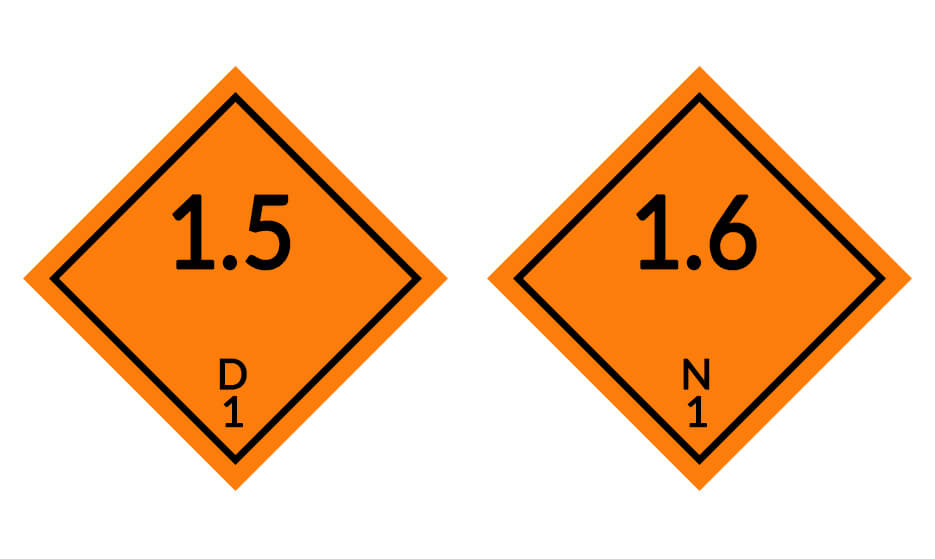
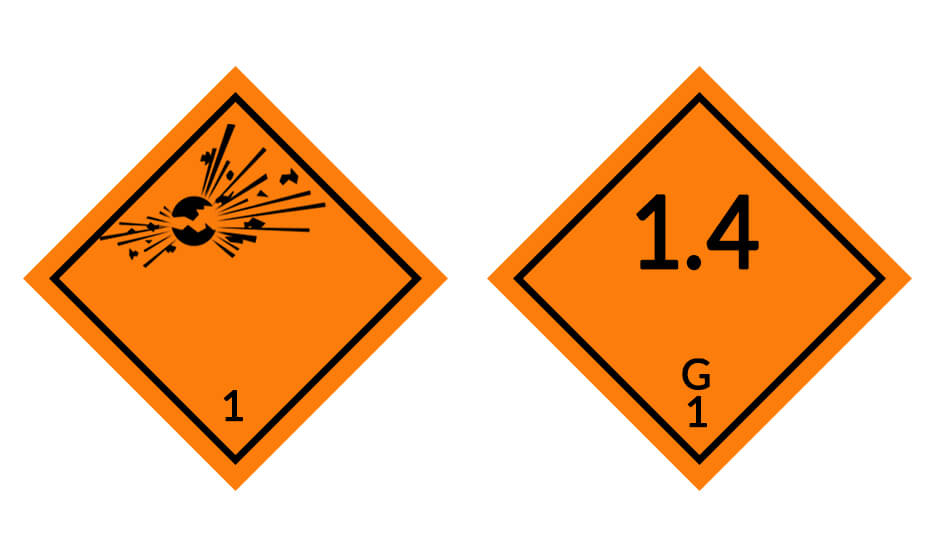
What are examples of Class 1 hazardous materials?
Examples of hazardous materials class 1 are:
- Nitroglycerine/dynamite,
- Rocket fuel,
- Demonstration or consumer fireworks,
- Ammunition.
What is Class 2 hazardous materials?
Class 2 hazardous materials are gases. It is divided into three categories:
- Flammable gases,
- Non-flammable/non-poisonous gases,
- Toxic gases.
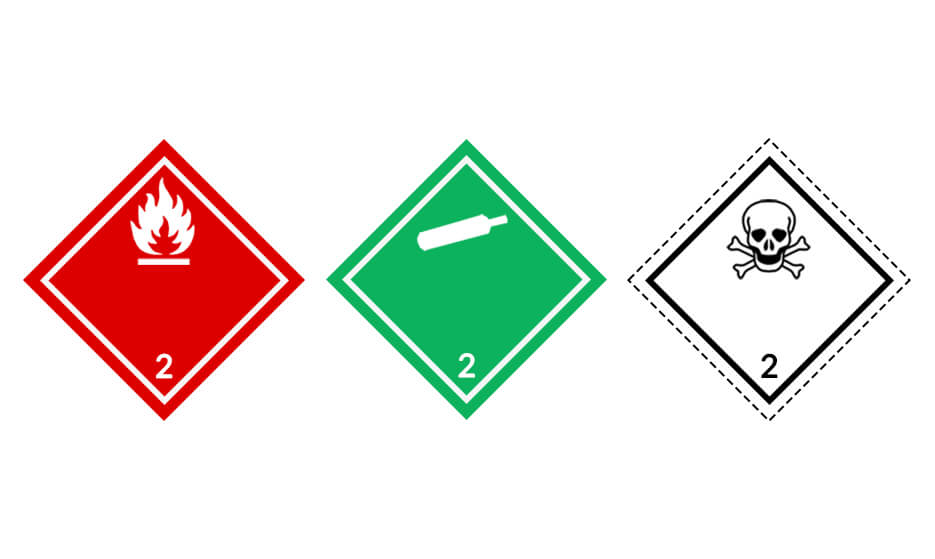
What are examples of Class 2 hazardous materials?
Examples of Class 2 hazardous materials are:
- Acetylene, hydrogen, propane (flammable gases);
- Nitrogen, neon, carbon dioxide ( non-flammable/non-poisonous gases);
- Fluorine, chlorine, hydrogen cyanide (poisonous gases).
What is Class 3 hazardous materials?
Class 3 hazardous materials include flammable liquids. They are divided into 3 packing groups:
- Packing group I: Liquids with an initial boiling point of 35°C or less at an absolute pressure of 101.3 kPa and any flash point.
- Packing group II: Liquids with an initial boiling point higher than 35°C at an absolute pressure of 101.3 kPa and a flash point lower than 23°C.
- Packing group III: Liquids that do not meet the criteria for inclusion in Packing Group I or II.
It is worth mentioning here that special chemical hoses are used to transport flammable liquids (and many other substances).

What are examples of Class 3 hazardous materials?
Examples of Class 3 hazardous materials are as follows:
- Diethyl ether and carbon disulphide (Packing Group I);
- Petrol and acetone (Packing group II);
- Paraffin and diesel fuel (Packing Group III).
What is Class 4 hazardous materials?
Class 4 hazardous materials are flammable solids. Those that ignite on contact with an external igniter or spontaneously.
Class 4 is divided into three categories:
- Flammable solids;
- Spontaneously combustible solids;
- Solids that react with water.
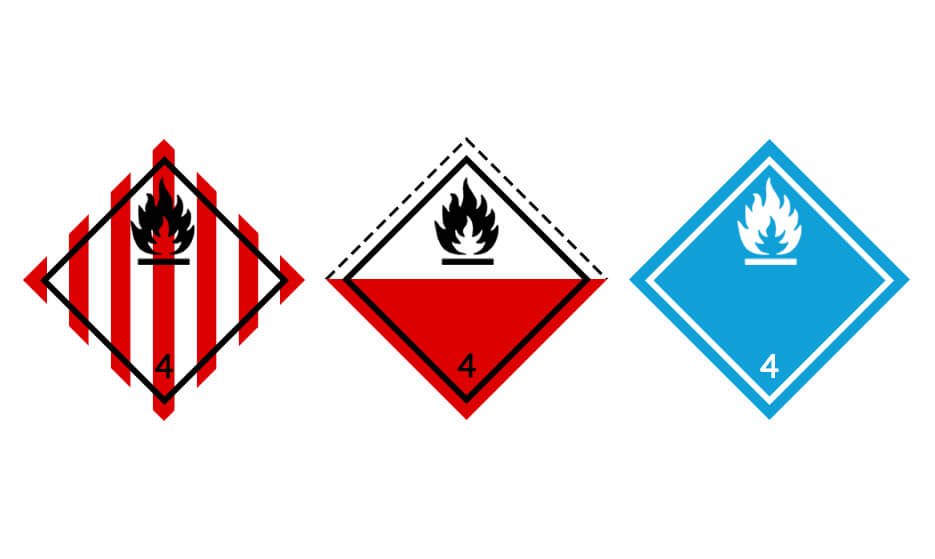
What are examples of Class 4 hazardous materials?
Examples of Class 4 hazardous materials are:
- Nitrocellulose and magnesium (flammable);
- White phosphorus (spontaneously combustible);
- Sodium, calcium, potassium (hazardous when in contact with water).
What is Class 5 hazardous materials?
Class 5 hazardous materials are oxidising substances and organic peroxides. These are divided into two separate subclasses:
- Oxidising agents (all except organic peroxides);
- Oxidising agents in the form of organic peroxides.
Oxidising agents are materials that, by giving off oxygen, can cause or accelerate the combustion of other materials. Organic peroxides, on the other hand, are any organic compounds containing oxygen (O) in the divalent structure -O-O-, which can be regarded as derivatives of hydrogen peroxide. The difference is that one or more hydrogen atoms have been replaced by organic radicals.
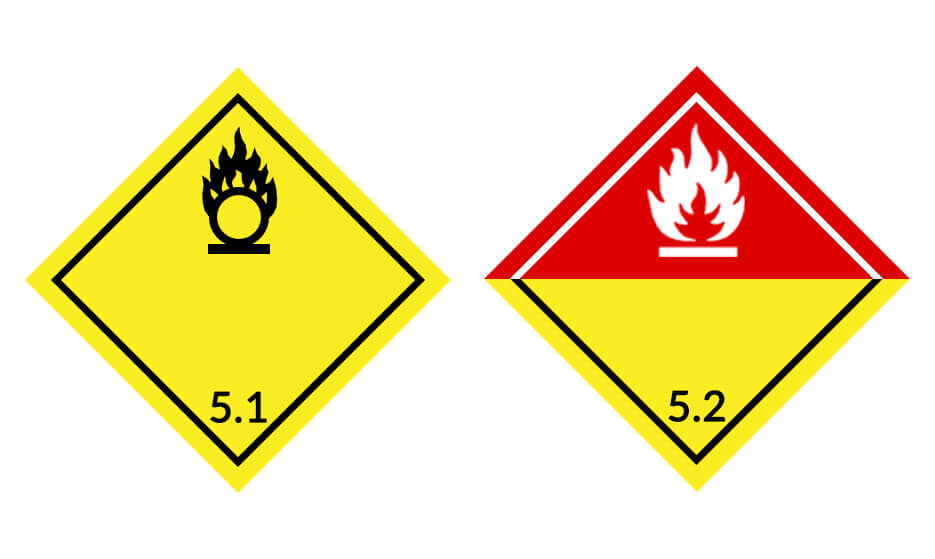
What are examples of Class 5 hazardous materials?
Examples of hazardous materials class 5 are:
- Calcium hypochlorite, ammonium nitrate, hydrogen peroxide and potassium permanganate (oxidising agents that are not organic peroxides);
- Benzoyl peroxides and cumene hydroperoxide (organic peroxides).
What is Class 6 hazardous materials?
Class 6 hazardous materials are toxic materials and infectious substances. It is divided into two subclasses:
- Materials toxic to humans that pose a health risk during transport. Also, those which (in the absence of adequate toxicity data) are presumed to be toxic to humans based on tests on laboratory animals;
- Infectious materials, containing pathogens that cause infection and disease.

What are examples of Class 6 hazardous materials?
Examples of Class 6 hazardous materials are as follows:
- Potassium cyanide and mercuric chloride (toxic materials);
- Viral cultures, pathological specimens and used intravenous needles (infectious materials).
What is Class 7 hazardous materials?
Class 7 hazardous materials are radioactive materials. This group includes any material containing radionuclides where both the activity concentration and the total activity in the consignment exceed specified values.
Class 7 consists of three subclasses: I, II and III.
They are defined on the basis of the transport index - a number indicating the potential hazard associated with the radioactive material. The transport index is calculated by multiplying the maximum radiation level at any point on the surface of the package by a factor of 10.

What are examples of Class 7 hazardous materials?
Examples of Class 7 hazardous materials are uranium and plutonium.
What is Class 8 hazardous materials?
Class 8 hazardous materials are corrosives. These include liquids or solids that destroy the full thickness of human skin at the point of contact within a specified time. Also, liquids or solids that show a high corrosion rate of steel or aluminium.
There are two types of substances here:
- Acids,
- Alkalis.
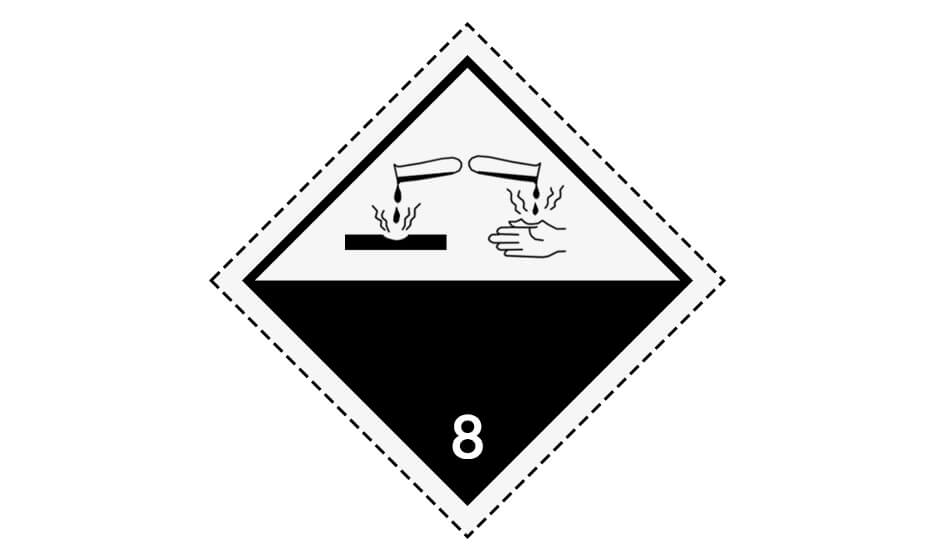
What are examples of Class 8 hazardous materials?
Examples of Class 8 hazardous materials are as follows:
- Sulphuric acid and hydrochloric acid (acids);
- Potassium hydroxide, sodium hydroxide (bases).
What is Class 9 hazardous materials?
Class 9 hazardous materials are various dangerous goods, materials and articles that do not fit into any of Classes 1 to 8.
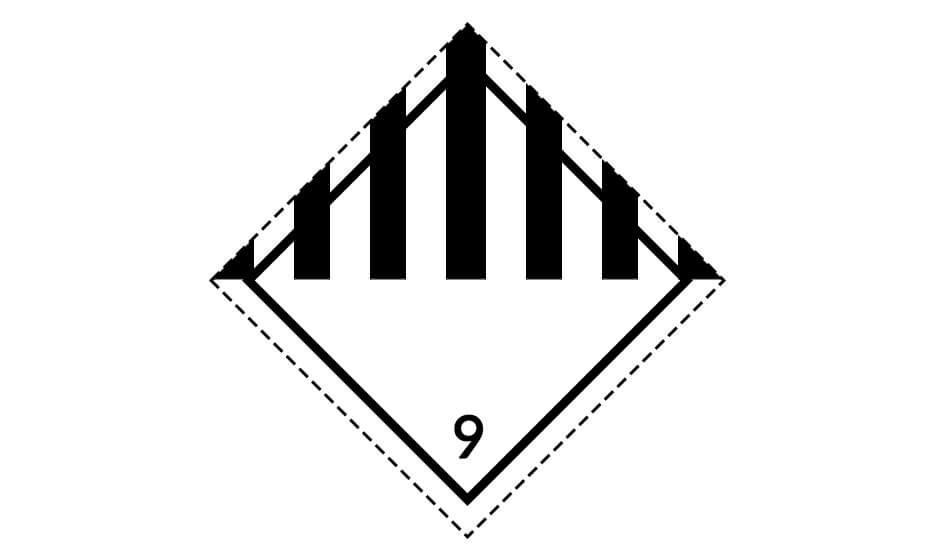
What are examples of hazardous materials class 9?
Examples of hazardous materials class 9 are:
- Asbestos,
- Airbag inflators,
- Self-inflating life rafts,
- Dry ice, Lithium batteries.
Summary
You already know the classification of hazardous materials created by the United Nations (UN). This is the basis for the various standards and regulations.
The classification of hazardous materials is extremely important for a number of reasons. First and foremost, it is about ensuring the safety of transport, as well as people and the environment. In addition, compliance with the law and effective action in the event of an emergency come into play.
In the UK, regulations for the carriage and storage of hazardous materials are governed by ADR, ADN, RID, IMDG, ICAO, and IATA.

Articles author
Bartosz Kułakowski
CEO of Hosetech Sp. z o.o.
Bartosz Kulakowski is an industrial hoses and couplings specialist with over 10 years of experience. Bartosz has been present in the technical industry since 2013. He gained experience as a technical and commercial advisor in the sector of plastic conveyor belts, steel structures, industrial hoses, and connectors. Since 2016, he has specialized exclusively in hoses and connectors. In 2019 he opened his own business under the HOSETECH Bartosz Kulakowski brand and since July 2022 he has been the CEO of the capital company HOSETECH Sp z o. o. (LLC).
Table of Contents
What are the classes of hazardous materials?
Why is the classification of hazardous materials important?
What are the standards for classifying hazardous materials?
What is a DOT standard?
What is NFPA 400?
Classes of hazardous materials according to the ADR standard
Table of classes of hazardous materials
What is Class 1 hazardous materials?
What is Class 2 hazardous materials?
What is Class 3 hazardous materials?
What is Class 4 hazardous materials?
What is Class 5 hazardous materials?
What is Class 6 hazardous materials?
What is Class 7 hazardous materials?
What is Class 8 hazardous materials?
What is Class 9 hazardous materials?
Summary
See also other categories
